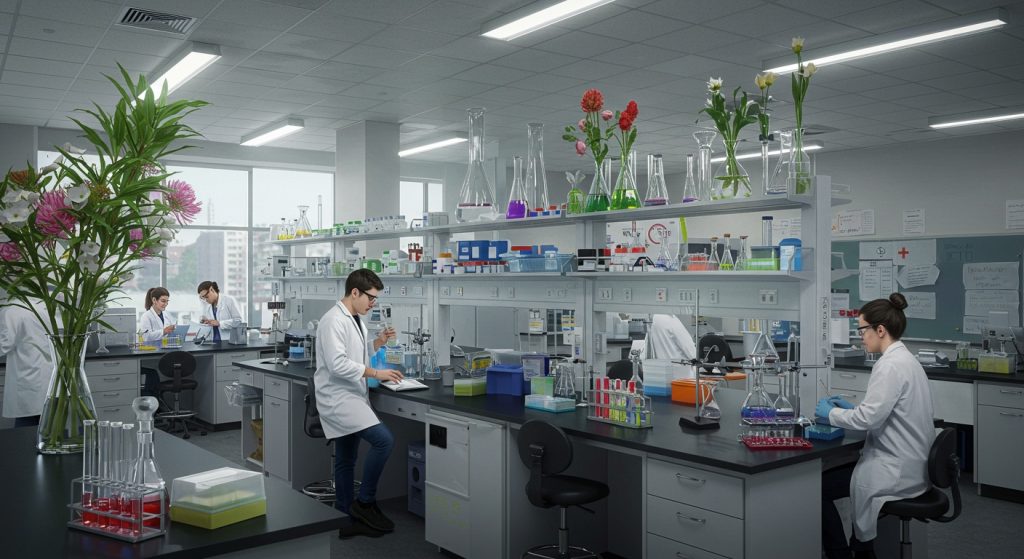Imagine a future where genetic diseases like Huntington’s and cystic fibrosis are relics of the past. CRISPR, a revolutionary gene-editing tool, is rapidly turning this vision into reality. Unlike traditional therapies that only treat symptoms, CRISPR offers the potential to correct the root cause of disease by precisely altering DNA. Recent advancements, such as base editing and prime editing, have expanded CRISPR’s capabilities, allowing for even more precise and targeted interventions. With clinical trials underway targeting a range of conditions from inherited blindness to certain cancers, CRISPR’s impact on medicine is poised to be transformative, potentially rewriting how we approach disease treatment forever.

Understanding CRISPR: The Basics of Gene Editing
CRISPR, which stands for Clustered Regularly Interspaced Short Palindromic Repeats, isn’t just a scientific buzzword; it’s a revolutionary gene-editing technology. Imagine having a pair of molecular scissors that can precisely cut DNA at a specific location. That’s essentially what CRISPR does. It’s based on a naturally occurring defense mechanism used by bacteria to protect themselves from viruses.
The key components of the CRISPR system are:
- Cas9 Enzyme: This acts like the molecular scissors, cutting the DNA strand.
- Guide RNA (gRNA): This is a short RNA sequence that guides the Cas9 enzyme to the precise location on the DNA that needs editing. The gRNA is designed to match the DNA sequence you want to target.
Here’s how it works:
- The gRNA guides the Cas9 enzyme to the target DNA sequence.
- Cas9 cuts the DNA at the specified location.
- The cell’s natural repair mechanisms kick in to fix the break. There are two main pathways for repair:
- Non-homologous end joining (NHEJ): This is a quick and dirty repair mechanism that often introduces insertions or deletions (indels), which can disrupt the gene. This is useful for “knocking out” a gene, rendering it non-functional.
- Homology-directed repair (HDR): If a DNA template is provided along with the CRISPR system, the cell can use this template to repair the break, effectively inserting a new gene or correcting a faulty one.
CRISPR’s precision and relative simplicity compared to earlier gene-editing technologies like ZFNs (Zinc Finger Nucleases) and TALENs (Transcription Activator-Like Effector Nucleases) have made it a game-changer in the field of Biotechnology. The ability to target specific genes with such accuracy opens up unprecedented possibilities for treating diseases at their genetic root.
CRISPR vs. Other Gene-Editing Technologies
While CRISPR is currently the most prominent gene-editing tool, it’s essential to comprehend how it compares to its predecessors:
| Feature | CRISPR-Cas9 | ZFNs (Zinc Finger Nucleases) | TALENs (Transcription Activator-Like Effector Nucleases) |
|---|---|---|---|
| Targeting Specificity | Uses guide RNA, easily programmable | Uses protein-DNA interaction, complex to design | Uses protein-DNA interaction, complex to design |
| Ease of Use | Relatively simple to design and implement | More complex and time-consuming | More complex and time-consuming |
| Cost | Generally less expensive | More expensive | More expensive |
| Off-Target Effects | Potential for off-target effects. Continually improving | Potential for off-target effects | Potential for off-target effects |
| Efficiency | High efficiency | Lower efficiency compared to CRISPR | Lower efficiency compared to CRISPR |
The table highlights the key differences. CRISPR stands out due to its ease of use, lower cost. High efficiency. While off-target effects (where the Cas9 enzyme cuts DNA at unintended locations) are a concern for all gene-editing technologies, ongoing research is focused on improving the specificity of CRISPR to minimize these risks.
CRISPR in Action: Treating Genetic Diseases
The most promising application of CRISPR lies in treating genetic diseases. These are diseases caused by mutations in our genes. By correcting these mutations, CRISPR offers the potential to cure these diseases, rather than just managing their symptoms. Here are some examples:
- Sickle Cell Anemia: This blood disorder is caused by a mutation in the gene that produces hemoglobin. CRISPR is being used to correct this mutation in bone marrow stem cells, which then produce healthy red blood cells. Early clinical trials have shown promising results, with some patients experiencing significant improvements in their condition.
- Cystic Fibrosis: This genetic disorder affects the lungs and digestive system. CRISPR is being explored as a way to correct the mutated gene responsible for cystic fibrosis in lung cells. While delivery of CRISPR to the lungs remains a challenge, researchers are making progress in developing effective delivery methods.
- Huntington’s Disease: This neurodegenerative disorder is caused by an expansion of a repeating DNA sequence in the huntingtin gene. CRISPR is being investigated as a way to silence the mutated gene, preventing the production of the harmful protein that causes the disease.
- Duchenne Muscular Dystrophy (DMD): DMD is a genetic disorder characterized by progressive muscle degeneration and weakness. It is caused by mutations in the dystrophin gene, which is crucial for muscle fiber stability. CRISPR-Cas9 technology is being explored to correct or skip over these mutations, allowing the body to produce a functional, albeit shortened, version of the dystrophin protein. This approach aims to slow down or halt the progression of the disease by improving muscle function and reducing muscle cell damage.
A personal anecdote: I recently attended a scientific conference where I heard Dr. Fyodor Urnov, a leading researcher in gene editing, present his work on using CRISPR to treat genetic diseases. He shared stories of patients who had participated in clinical trials and experienced life-changing improvements in their health. It was truly inspiring to see the potential of this technology to transform lives.
Beyond Genetic Diseases: CRISPR for Cancer and Infectious Diseases
CRISPR’s applications extend beyond genetic diseases. It’s also being explored as a tool to combat cancer and infectious diseases:
- Cancer Immunotherapy: CRISPR can be used to engineer immune cells, such as T cells, to better recognize and attack cancer cells. This approach, known as CAR-T cell therapy, has shown remarkable success in treating certain types of blood cancers. CRISPR can enhance CAR-T cell therapy by improving the targeting and effectiveness of T cells.
- Targeting Cancer Cells Directly: CRISPR can be used to directly target and disrupt genes that are essential for cancer cell growth and survival. This approach is still in early stages of development. It holds promise for treating cancers that are resistant to conventional therapies.
- Fighting Viral Infections: CRISPR can be used to target and destroy viral DNA or RNA within infected cells. This approach is being explored as a potential treatment for HIV, hepatitis B. Other viral infections. Researchers are also investigating using CRISPR to develop new diagnostic tools for detecting viral infections.
For example, studies have shown that CRISPR can effectively target and eliminate HIV DNA from infected cells in the lab. While challenges remain in delivering CRISPR to all infected cells in the body, this research offers a glimmer of hope for a potential cure for HIV.
The Ethical Considerations of CRISPR Technology
The power of CRISPR comes with significant ethical responsibilities. The ability to alter the human genome raises concerns about unintended consequences, off-target effects. The potential for misuse. Some of the key ethical considerations include:
- Germline Editing: This involves making changes to genes in sperm, eggs, or embryos, which would be passed down to future generations. Germline editing raises concerns about the potential for unintended consequences on the human gene pool and the possibility of creating “designer babies.” Most scientists and ethicists agree that germline editing should only be considered in cases where it is necessary to prevent serious genetic diseases and when there are no other reasonable alternatives.
- Somatic Cell Editing: This involves making changes to genes in non-reproductive cells, such as blood cells or lung cells. Somatic cell editing is generally considered to be less controversial than germline editing, as the changes are not passed down to future generations. But, there are still concerns about the potential for off-target effects and the long-term safety of this approach.
- Equitable Access: Ensuring that CRISPR-based therapies are accessible to all who need them, regardless of their socioeconomic status, is a critical ethical challenge. If these therapies are only available to the wealthy, it could exacerbate existing health disparities.
- Informed Consent: Patients participating in clinical trials of CRISPR-based therapies must be fully informed about the potential risks and benefits of the treatment. They must also be given the opportunity to ask questions and make an informed decision about whether to participate.
The scientific community is actively engaged in discussions about the ethical implications of CRISPR technology and developing guidelines for its responsible use. International collaborations and regulatory frameworks are needed to ensure that this powerful technology is used in a way that benefits humanity.
Conclusion
CRISPR technology offers immense promise. Remember, it’s not a magic bullet. As we’ve explored, the potential to eradicate genetic diseases like Huntington’s or enhance immunotherapies for cancer is tangible. But, responsible application is key. Stay informed about ongoing clinical trials and ethical debates; resources like the National Institutes of Health website (https://www. Nih. Gov/) are invaluable. Personally, I believe the future of medicine hinges on informed public discourse. Don’t shy away from engaging in conversations about CRISPR’s societal implications. Grasp that current research is focused on refining delivery methods to ensure accuracy and minimize off-target effects. The journey towards widespread CRISPR-based therapies will be long. With careful navigation and ethical consideration, this technology holds the potential to reshape treatment as we know it, offering hope for a healthier future.
More Articles
Top Universities: Your Guide to the Best German Engineering Programs
Budget-Friendly Guide: What is the Real Cost of Living in Germany?
Your Step-by-Step Guide: Mastering the German University Application Process
A Complete Guide: Navigating Student Life in Germany as an International Student
FAQs
So, what exactly IS CRISPR? Sounds kinda sci-fi!
Yeah, it does sound like something out of a movie! , CRISPR is a tool that lets scientists edit DNA – the instruction manual for our cells. Think of it like a super precise word processor for your genes. It can cut, delete, or even paste in new DNA sequences. Pretty cool, huh?
Okay, gene editing is neat. How could it actually treat diseases?
Great question! Many diseases are caused by faulty genes. CRISPR offers the potential to correct those faulty genes directly. For example, if someone has a genetic mutation that causes a disease, CRISPR could theoretically be used to snip out the bad gene and replace it with a healthy one. It’s like fixing a typo in your genetic code that’s causing big problems.
Are we talking about curing diseases like cancer with CRISPR? Is that really possible?
That’s the hope! While it’s still early days, there’s a lot of promising research into using CRISPR to treat cancer. It could potentially be used to target and destroy cancer cells, or even to boost the immune system’s ability to fight cancer. It’s not a guaranteed cure-all yet. It’s a really exciting area of development.
What kinds of diseases are researchers already looking at treating with CRISPR?
You name it, scientists are probably looking at it! But some of the most actively researched areas include genetic disorders like cystic fibrosis and sickle cell anemia, as well as infectious diseases like HIV. There’s also a lot of interest in using CRISPR for certain types of blindness and muscular dystrophy.
Sounds amazing. Are there any risks involved? I mean, messing with genes sounds kinda risky…
You’re right to be concerned, it’s not a risk-free technology. One major concern is ‘off-target effects,’ where CRISPR accidentally edits the wrong part of the DNA. Scientists are working hard to improve the precision of CRISPR to minimize these risks. There are also ethical considerations to think about – like, should we be able to edit genes that get passed down to future generations?
So, how far away are we from seeing CRISPR treatments become widely available?
That’s the million-dollar question! Some CRISPR-based therapies are already in clinical trials, which is a big step. It’s tough to say exactly when they’ll become widely available. Many experts believe we could see some approved CRISPR treatments within the next few years. It’s a rapidly evolving field, so stay tuned!
If CRISPR becomes common, will it be super expensive? Like, only for the rich?
That’s a really crucial question. Something that needs to be addressed. Like any new technology, the initial treatments are likely to be expensive. But, as CRISPR technology becomes more established and efficient, the cost should come down. It’s crucial to ensure that these treatments are accessible to everyone who needs them, not just the wealthy.


